

There are some creatives who avoid digital painting and stick to real-world tools exclusively. I am not one of them. I feel fortunate to live in an era with so many other options. For example, my handwriting stinks, so the 21st century standard of using fonts in word balloons is a nice development. Another issue is that, before drawing with electricity became affordable, I actually drew with Bic pens because I despised the giant mess traditional art created. I don't want to bother with 60 different brush sizes, expensive poster board, and dry pens with nibs that you have to dip into an inkwell before every stroke. (When is this, 1895? Why would anyone actually want that?)
Given that I've been experimenting with digital art production for a long time, I thought it was time to pass on the knowledge I've gained and explain your options, now that I've tried them all. Including the......
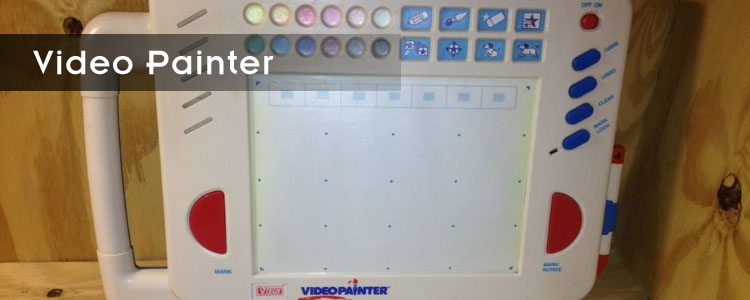
Technically I started working digitally in December of 1992, when I got this amazing piece of sorcery for Christmas. Anything you drew on the pad showed up on the TV. If you plugged it into the VCR, you could record the drawings one at a time and make your own TV specials. You better believe I took advantage of that.
Imagine flipping through the channels and having the power to do nonsense like this. I was truly privileged.
Years later, when YouTube was invented, I eagerly entered "Video Painter" into the search bar to see what OTHER people had created with the device. To my dismay, I found nothing. I just checked now, and there's still nothing. You've all gotta be kidding me.
The Video Painter was not a flop; it sold well enough to spawn an updated model and a Disney-licensed variant. Was I really the only person who actually used the thing? Was I the only kid living his dream in the early 90's, instantly creating crude TV shows by stabbing at a cushioned pad? That's depressing. VTech basically made a toy for me and no one else.
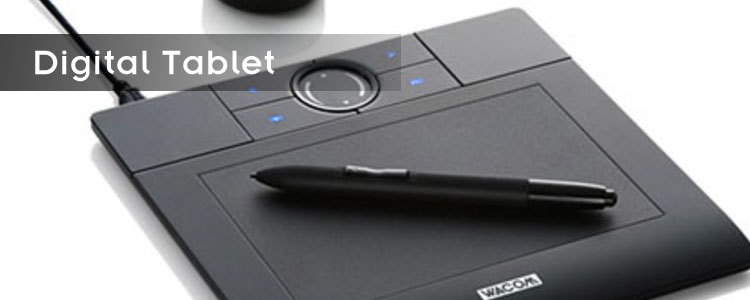
In the olden days of 2003, when you said the word "tablet" everybody knew you were referring to this: the Bamboo or the Intuos, a gray pad you put on your lap and drew on while looking up at the computer monitor. Now "tablet" in mainstream terms refers to something that can't help with art at all, much to my annoyance (but more on this later).
Most artists have these. They're cheap and easy to get. However, most owners of digital tablets only use them for touch-up work once the art they created from more traditional means is scanned into their computers. The reason for this is the drawing tablet's biggest flaw: it's awkward to use. You're not drawing directly onto paper, you're making lines somewhere while watching them appear somewhere else. This "somewhere" is either the computer desk or your own lap.
When I got my first drawing tablet ten years ago, I was coming off years of training via the Video Painter. I was already comfortable with drawing from the lap, and so I went all-digital from this point. With practice, the awkwardness goes away and becomes natural, but a lot of people just don't bother -- they prefer a hybrid technique with actual paper. If that's you, the drawing tablet should be enough. But if you want to work with digital media exclusively, you're going to need to make a bigger investment.....
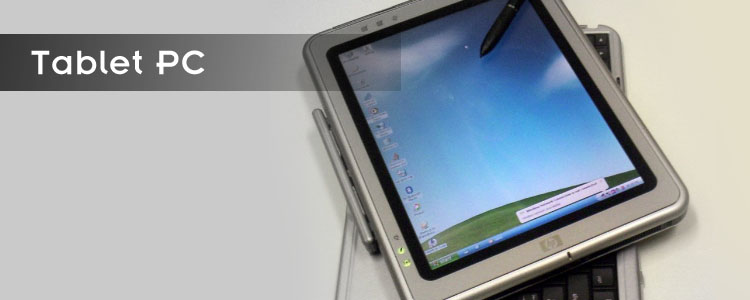
Despite what the breakdancing people in Microsoft commercials would have you believe, tablet-slash-PC hybrids were not invented in 2012. They existed for over a full decade beforehand. The only difference was that they were heavier and that you couldn't use your finger to select things, but that option means nothing to a digital artist who's already holding a plastic stylus.
Be warned that once you try the Tablet PC, you can never go back to the digital tablet -- your body will not let you. It's too much of an improvement; it's like getting indoor plumbing for the first time in your life. So if you can't afford one yet, don't bother until you can.
Most Tablet PCs are laptops with monitors that swivel around and fold down over the keyboard, turning into tablets (you'll have to supply your own CHR-CHE-CHK Transformer noise). Being able to draw directly onto the screen improves things immensely, because it allows you to take full advantage of options like paint filling and instantly undoing mistakes. You'll be able to finish art in a shorter amount of time.
Before buying your first tablet PC, be sure to research the type of pen it has. Most styluses for Tablet PCs are manufactured by Wacom, a corporation with a monopolistic patent on digital pens. Wacom pens do not contain batteries, but communicate with the computer via fancy magnet powers. This fortunately means that Wacom pens are easy to replace, as all of them will work with any PC running their special drivers. (That's another thing -- as soon as you get a Tablet PC, be sure to download the drivers from Wacom's website before you do anything else. For some reason they don't come built-in.)
If you don't buy a tablet with a Wacom stylus, you're gonna have a bad time. It rarely happens, but some PCs out there use an N-Trig pen, which is a different kind of technology. The problem is that this kind of pen doesn't work with Photoshop or Painter, and if you're a digital artist, you likely rely on one of those.
This option is in between the Cintiq and the digital tablet, pricing-wise. New tablet PCs run around $1000, but used or refurbished ones can be snatched on eBay for $300 to $400. If you have specific questions, use this forum to figure out the best tablet PC for your needs.
It would also be wise to get yourself a protective cover for the Tablet PC's screen. Over the next few years, you're going to be slashing and stabbing at your monitor, and you will eventually start scratching it up, making it potentially unusable. Your best option is to get one from Photodon.com, which makes screen protectors specifically for Tablet PCs and will even cut their film to any size you're looking for.
Now for the bitter truth. I've been struggling as of late to get the newer Tablet PC models to work, and returning them within a week. What I eventually figured out was that there's some kind of issue between Windows 7 and Wacom drivers that has not been resolved. I've installed many different versions of drivers and for the most part the calibration has been horrible; the cursor appears to the slight left of the stylus in random areas, which, when you're trying to draw, is an impossible defect to work with. Wacom's newest driver worked, but also caused a half-second delay between making a pen stroke and having it appear. The only solution was to shut off other background functions like the sensor that changes the display when you turn the screen around, producing other, unrelated headaches to deal with. Good luck is what I'm saying.
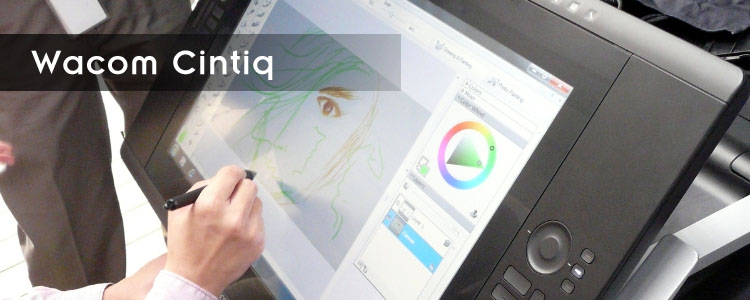
Hey, big spender! This is the largest and most durable digital art tool you can buy. All the professionals with big names use Cintiqs. Pixar and Dreamworks are humming with them. That hack who draws "Luann" uses a Cintiq. The average model costs $2000 and must be ordered online, adding expensive shipping charges to the bill. Here's the big catch-22; considering the income of the average artist, the people who would most benefit from a Cintiq can't afford one. But surely it must be better than a Tablet PC, right? ......well, there are advantages and disadvantages to each.
The biggest advantage a Tablet PC has over a Cintiq is that you can take it anywhere. If you feel like drawing on the floor -- and I often feel like drawing on the floor -- you can do just that. But a Cintiq is heavy. Very heavy. The newer models weigh upwards of 60 pounds. You can't use it anyplace other than where you decide to put it, and even if you're Artie, the Strongest Man in the World, that still doesn't matter because it must be tethered to your computer and can't operate independently. The Cintiq is really a second monitor.
One advantage it has over any other digital means is obvious -- it's big. There's a lot of space to draw on, and that does make a difference. A lot of time is saved when you can have everything you need open at once instead of switching between images or windows. It's also got an impervious monitor that can take any form of stylus-related abuse. In fact, most Cintiqs come with extra pen tips because it's the PEN that will wear down eventually.
The Cintiq has 2048 levels of pressure sensitivity; the Tablet PC has 256. Generally, you won't notice much of a difference between the two, except in subtle areas. Tablet PCs have a problem with very light brushstrokes; you'll often find they don't register. A Cintiq picks up everything, allowing you to draw much finer lines. This minor problem won't affect you THAT much; if you can't afford a Cintiq, you should be fine with a Tablet PC. But the Cintiq is still a cool thing to have if you can get it.
So why can't you have the best of both worlds? Why can't I have a portable gadget with the sensitivity of a Cintiq and the freedom of a tablet PC? Why are we, as a society, drowning in light pads that do everything BUT draw well?
I don't know what the issue was. But it was finally resolved on October 1, 2013.
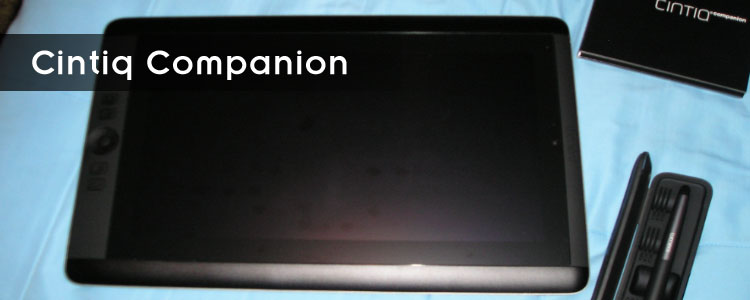
Yes, it finally exists...the portable Cintiq. It's very rare that I'm in a position to spend this much on a single product, but the moment the Companion was available for purchase, I was -- and never looked back. This is the tablet of my dreams, the kind of thing I've been trying to pound Tablet PCs into becoming. It's what I wanted the original iPad to do, but Steve Jobs reportedly viewed pens as "a sign of weakness." I loathe that dead man.
The Cintiq Companion comes in four different models: two that run on Android and two that run on Windows, with two sizes of SSD storage space to choose from. The Android model is the cheapest at $1499, but I really needed Photoshop and went for the $2000 Windows version. This version has a 256 GB solid-state drive, and they also make one with 512 GB for $500 more, but given that I tend to save everything on flash drives, I would never need that much.
Past touchscreen-stylus hybrids have had issues with reading both forms of input at once, but the Companion has no such problem and always remembers to shut its finger sensors off when the pen is in proximity. (Even if something goes wrong, there is a button to turn the touch function off.)
Downsides are few and petty, but they're there. For one thing, buying this introduced me to the New Cintiq Smell, which still hasn't left the drawer I keep it in months after I bought it. The padded case absorbed that smell like a sponge and it may be with me for a long time. Another annoyance: it's only made to be used horizontally. You CAN work in vertical mode, but the monitor is so long and skinny that way, it's too awkward to try.
Unlike Tablet PCs, the Companion has no built-in holder for its stylus. I guess they figure if you're the kind of person who can spend this much on a tablet, you probably aren't dumb enough to lose the pen. The stylus sort of fits in the padded case, but it was meant to be stored inside a snooty holder with a lid that comes with the Companion.
There's no instruction manual either, nor are there in-system instructions. You know how the original Legend of Zelda opens? Turning on the Cintiq Companion feels a lot like that. Someone says "It's dangerous to go alone, take this," gives you a stylus, and then disappears leaving you to figure out everything on your own. There are sure a lot of buttons on the left side, but the only way to figure out what they do is to press them all.
Overall, it's a godsend. They're expensive now, but when competitors start appearing, the price should go down. The threshold has finally been crossed, and I expect the art tablet to become a commonplace tool in a few years, turning the old Bamboo and Intuos into eight-track relics.
You may have noticed I never discussed the most important part of digital art making: the software. The thing is, that element is kind of subjective. I, myself, love Photoshop for drawing cartoons. Other people have told me I'm a fool for using software meant for PHOTOS and that programs built specifically FOR art making are much better, but....I've tried them, and they don't work for me the way Photoshop does. So....if it were up to me, I'd recommend Photoshop. This, however, may not be the solution for YOU. It might be Painter, or Gimp, or Paint Shop Pro. I can't give you perfect advice on that sort of thing. because I'm not you. You will have to experiment on your own.